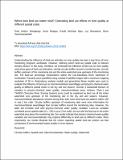| dc.description.abstract | Understanding the influence of land-use activities on river quality has been a key focus of river monitoring programs worldwide. However, defining which land-use spatial scale is relevant remains elusive. In this study, therefore, we contrasted the influence of land use on river quality using three types of land-use estimators, namely circular buffers around a monitoring site, circular buffers upstream of the monitoring site and the entire watershed area upstream of the monitoring site. The land-use percentage compositions within the Usa-Kikuletwa River catchment in northeastern Tanzania were quantified using Landsat-8 satellite images with a maximum mapping resolution of 30 m. Redundancy analysis models and generalized linear models were used to evaluate the influence of land use on macroinvertebrate assemblages and physico-chemical water quality at different spatial scales in the dry and wet seasons. Overall, a substantial fraction of variation in physico-chemical water quality, macroinvertebrate taxon richness, Chao-1 and TARISS (Tanzania River Scoring System) score could be explained by land use of the entire watershed area upstream of the monitoring site in the dry and wet seasons. However, macroinvertebrate abundances showed strong links with more local land-use patterns within 100 m and 2 km radii. Circular buffers upstream of monitoring sites were more informative for macroinvertebrate assemblages than circular buffers around the monitoring sites. However, the latter did correlate well with physico-chemical water quality variables. Land-use variables correlated across spatial scales (i.e., 100 m up to 2 km radii), but not with the land use in the entire watershed area above the monitoring site. Our results indicate that physico-chemical water quality variables and macroinvertebrates may respond differently to land-uses at different scales. More importantly, our results illustrate that the choice regarding spatial land-use metrics can bias conclusions of environmental impact studies in river systems. | en_US |

